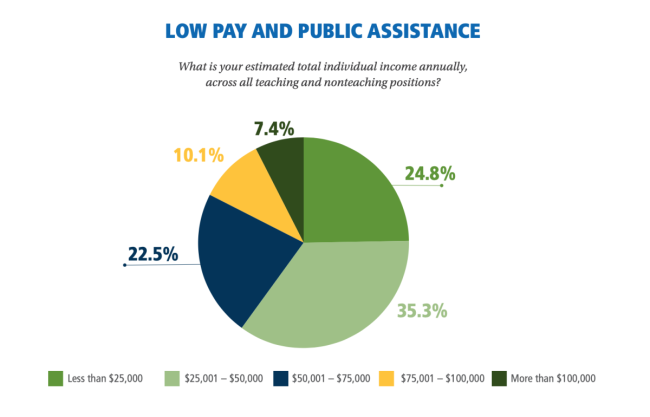You have /5 articles left.
Sign up for a free account or log in.

From the new AFT report on adjunct working conditions
American Federation of Teachers
A new study from the American Federation of Teachers shines a harsh light on working conditions for adjunct professors—and provides additional insight into how the pandemic has affected this faculty group in particular.
The upshot: adjunct academic work was precarious even before the pandemic, and the coronavirus made “a grave situation even worse.”
“When campuses were shut down in March 2020, adjuncts were given only hours to move their classes online, often without sufficient training or technical support to make the transition successful,” the study says. “They faced an academic year of uncertain enrollments and employment prospects, compounded by the anxieties of being asked to return to the classroom amid a checkered public health response to the pandemic.”
That’s in addition to food insecurity, limited health-care coverage and housing issues, according to the AFT.
The new study is based on a survey of about 1,900 adjunct instructors at two- and four-year institutions fielded from May to August 2020.
Struggling Financially—and in Some Cases Medically
Nearly a quarter of respondents said they earn less than $25,000 per year, below the federal poverty guideline for a family of four. Another one-third of respondents earn less than $50,000.
Just 20 percent said they could comfortably cover basic monthly expenses. Some 48 percent struggle with job security, reporting that they don’t know if they will have a teaching assignment a month ahead of the start of classes.
Three out of four adjuncts surveyed said their employment is guaranteed only from term to term.
About 50 percent of respondents said they are paid less than $3,500 per course, consistent with AFT’s last big survey of adjuncts, published in 2020. Teaching a 4-4 load, or four courses in each of two semesters, as was typical among respondents, would lead to only $28,000 in income before taxes and other deductions, the report notes.
More than 50 percent of adjuncts said they should be paid at least $5,000 a course.
Historian Stephen Leccese, who is now a research analyst, said Wednesday that he left adjuncting in 2019, ahead of COVID-19, because “it’s not a sustainable living.”
Leccese, who did not contribute to the AFT report, said that when he was teaching in the City University of New York system, he made $3,200 per class. “Even if I were to teach the CUNY max course load of nine hours per week—three classes in fall and spring each, one class in winter and summer each—I would be making $25,600 before taxes,” he added.
Some 22 percent of respondents said they had problems accessing adequate food or opted to reduce the quality of the food they eat to get by. Four percent reported they’ve had to eat less to get by in the last year.
Some 37 percent of respondents said they see no path to retirement.
Fewer than half of respondents have access to employer-provided health insurance, and about 20 percent rely on Medicaid. Some 45 percent of adjuncts said they’ve put off getting needed health care, including mental health services, in the last year due to cost concerns, and 64 percent have forgone dental care.
When they’re not actively teaching at certain points during the year, 35 percent of respondents reported struggling financially.
Rebecca Givan, an associate professor at Rutgers University’s School of Management and Labor Relations who studies academic labor, and who was not involved in AFT’s report, said the findings seem in line with her own observations of how “these institutions are absolutely dependent on adjuncts to teach for them, yet the adjuncts are not able to make a living and are dependent on public programs.”
The AFT report reviews the dramatic shift in academic labor over the last 40 years, from about 70 percent of professors being tenure-eligible or tenured to 75 percent of instructors being tenure-ineligible today, and about 47 percent holding part-time positions.
Over the same period, public funding for higher education has failed to keep up with inflation, and management staff positions have proliferated, the report says. The AFT laments the nonpassage of the federal Build Back Better Act, which “would have provided much-needed resources for colleges and universities, which could have been used to improve the working conditions of contingent faculty.” Additionally, the report says, the act would have strengthened “the social safety net on which adjuncts and contingent faculty rely, with expanded access to healthcare, lower prescription drug prices, lower childcare costs, expanded paid parental leave, and a host of other improvements that would have directly benefited contingent faculty and other members of our community.”
Some 74 percent of survey respondents were white, 4 percent were Black, 6 percent were Hispanic and 5 percent were Asian or Pacific Islander (among other demographic groups). Sixty-four percent were women, consistent with other data suggesting that women are overrepresented among contingent professors.
As for qualifications, 39 percent of respondents had a nonterminal master’s degree, 17 percent had a terminal master’s degree, 5 percent had a professional degree, 5 percent were finished with their doctoral studies but hadn’t finished their dissertation, and 23 percent had a Ph.D.
Maria Maisto, president of the New Faculty Majority, a national adjunct advocacy organization, said that the report shows “what contingent faculty activists have also been warning about for many years, namely that the contingent faculty population is getting older, and that health and retirement are real issues that are already at crisis levels, as they are across the country and across many sectors.”
The Student Success Link
Despite their relatively low pay, some 80 percent of respondents advised students informally at least once a month, without compensation. Some 68 percent helped students with class content that was not from the course they were assigned to teach. Just 41 percent of respondents said they have a private space to meet with students, and 44 percent said they had a private space on campus to do work.
“Students do not know the difference between tenured and contingent faculty, they just know which faculty members they feel most comfortable with,” the study says. “Institutions of higher education are creating and perpetuating a system of exploitation at the expense of their faculty, hiding this fact in plain sight from the students and families whose tuition dollars pour into that system each year.”
When full-time positions do become available at their institutions, only 26 percent of respondents said current adjuncts are given full consideration. Just 17 percent said the hiring process for these opportunities is transparent.
Adrianna Kezar, director of the Pullias Center and the Delphi Project on the Changing Faculty and Student Success at the University of Southern California, wasn’t involved in the study but said that the AFT had gathered “critical data to underscore how institutions are failing to support adjuncts” and how the pandemic has made these workers “even more vulnerable.”
Kezar emphasized how this inevitability impacts students, who “more now than ever [need] support from faculty.”
Maisto agreed, saying, “It is so important for people outside of higher education to understand the direct relationship between faculty working conditions, student learning conditions, and the common good—public health, civic engagement, the health of democracy.”
Givan, at Rutgers, said adjuncts are, for instance, “doing both formal and informal advising, but they don’t have a space to meet with students privately. So what are these students getting in terms of access to faculty? It sort of shows a culture of disrespect.”
Numerous institutions have openly acknowledged considering laying off tenure-track and even tenured professors in response to the financial uncertainties surrounding the pandemic. Givan said that untold numbers of adjuncts have faced “hidden” layoffs during COVID-19, in the form of contract nonrenewals.
“The employers don’t want that to be labeled as layoffs, but to the adjunct faculty member,” especially those whose contracts had been renewed for years prior, “it’s a layoff.”
Similarly, Givan said that while many tenured professors have spoken out against teaching conditions and health and safety concerns during the pandemic, “adjunct jobs are so insecure that they don’t really have the ability to push back because they need to stay in the good graces of their employer to get courses for the following semester. So even when they didn’t have the resources they needed to move their classes online, they’re not in a strong position to ask for better support.”
Givan said that the pandemic ultimately demonstrated that legislators need to step in and enforce pay parity—the idea of equal pay for equal work among part-time and full-time professors—among other improvements to adjunct working and, by extension, student learning conditions.
“Depending on large numbers of low-paid instructors without health insurance throughout a global pandemic—if that won’t make employers step up and do the right thing, then nothing will.”





